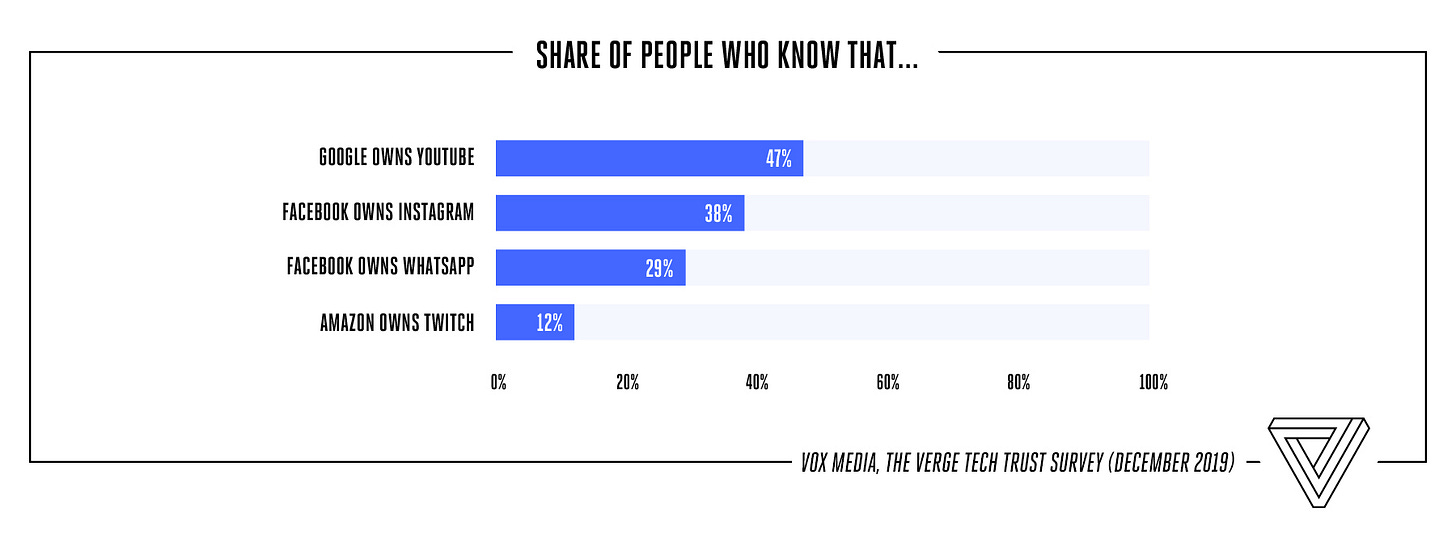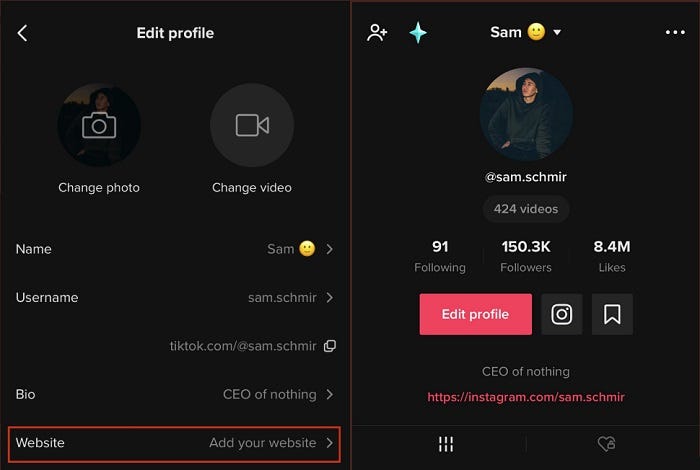There’s a lot of info to get to this week, from the crisis of trust affecting just about everything, to Twitter releasing the Fleet and more moves by IG, Byte and Tik Tok. Let’s get to it.
The Big Stuff

Banksy
Trust me.
The Verge released its 2020 tech survey this week, and the results are both unsurprising and paradoxical. Respondents believe large tech companies should be broken up if they control too much of the economy, yet give Amazon (who controls 49% of all online retail shopping) an overwhelmingly favorable score.
That seems to be the theme: personal “productivity” platforms like Amazon and Google are a good thing, but social media platforms like Facebook and Twitter are bad. Netflix and YouTube are good, Slack and Instagram are bad. If it helps get stuff done, or ironically not get stuff done, I like it. If it makes life busier and more stressful, I don’t.

So what’s with the odd results? One explanation could be that people trust what they know, and therein lies the knowledge gap. A vast majority of users either don’t know or don’t care about what goes on behind the scenes.
Less than half of those surveyed knew Google owns YouTube, only a third were aware Facebook owns WhatsApp, and just one-tenth knew Amazon owns Twitch.

This was also mirrored in the annual Edelman Trust Barometer report released this month. The global report showed a similar trend, with trust in institutions, business, and media at all-time-lows across the globe. In particular, 66% feel technology has to lead to our doubting if anything seen and heard is real anymore, and 61% feeling that governments do not understand and are not effective in regulating emerging technology.
It’s a new world out there where no one trusts what they see and hear. Authenticity and honesty are now your best commodity. Building and retaining trust with your audience will pay off with loyalty.

On the clock: should your brand be using Tik Tok?
I hate to tell you what you already know, but there’s no point in spending time (money) on producing content and supporting growth and engagement on a platform where you have no inherent audience. You’d be way better off following classic business strategy: find your niche and be best at it.
You’re always going to need to have a Facebook page (you wouldn’t NOT put your phone number in the Yellow Pages), but you may not need a Pinterest account. Or spend hours making IG stories.
But the world of social is a world of experimentation. How to perfect the “right people, right time, right place” formula fills social pros with existential dread every time a new platform rises from the pile to superstardom.
Yup, I’m talking Tik Tok. As people across most demographics flock to the new hotness, brand managers are feeling the pressure to decide if they should, or should not, hop on board. And it falls to us to answer that inevitable question. Sure, you could just buy ads, but I’m not sure that’s an answer to achieving any long-term success on social media anywhere.
Jam 3 Strategist Melissa Eshaghbeigi has penned a great article that can help you do a little guided critical thinking. It’s worth the read through, and here’s a quick checklist:
Are you universal? Can you see your brand having mass appeal across users 13-26, but also up to 50? Consistently?
Are you weird? Tik Tok thrives on the outlandish and silly. Do your brand guidelines allow you to create content Tik Tok users want to see?
Are you relevant? Being “in on the joke” is part of the zeitgeist. Don’t try too hard and end up on a “Brands Saying Bae” list.
There always value in spending time and experimenting. But ask yourself if a youthful, hyper-niche, community-driven platform reflects both your brand values and includes conversations you want to be a part of. It’s OK if the answer is no.
Any brand can be on TikTok so long as the content is good and they understand this isn't about them, it's about the audience. - Melissa Eshaghbeigi
The Small Stuff
As we mentioned last week, here comes Twitter Stories, aka Fleets. More on this in the coming weeks as testing expands, but they look to launching as text only updates with a time limit.
At this point, I think every major platform now has a vertical update option. Yes, even LinkedIn is testing story-style updates.
Byte is self-funding it’s first round of influencer content. The program will start with 100 US creators, who “people who regularly post, make full-screen portrait videos, and are positive members of the community”. Sound like you? You can apply here.
Twitter is expanding its definition of hate speech to include age, disease, and disability. Good.
Instagram looks to be testing video responses to IGTV content.
Facebook shows off it’s new Deep Entity Classification system for sniffing out fake accounts. The system examines over 20,000 points to try and determine if accounts are genuine.
Did your brand page see a drop in likes/followers last week? Looks like Facebook executed a purge. Purges happen on a regular basis, and most don’t even notice it (purges usually affect accounts that don’t interact with pages).
Facebook announced the rollout of a new, simplified Messenger app; ditching chatbots and the Discover tab. The new app runs on MSYS, new code destined to integrate messaging from Facebook, Instagram, and Whatsapp…
“…without promotion via Discover, businesses will have to rely on their owned or paid marketing channels to gain traction for their chatbots. That could discourage them from building on the Messenger platform.” Or, you know, pay for more ads.
More: Facebook released an updated Best Practices guide for brands to effectively communicate via Messenger.
The mobile version of Facebook’s new-ish Creator Studio is now available for iOS and Android. I imagine this will eventually replace Pages Manager (which has always been clunky to use on the go).

Tik Tok spotted testing URLs in bios as an attempt to woo more brands with a way to drive site conversions.

Is Jack on his way out of Twitter? Behind the scenes, there’s a Succession-style battle raging.

Brands are seeing huge views on self-serve ads on Tik Tok, but with a lack of metrics, it’s not yet clear if it’s translating into value. Good thread here:

Bonus for your phonus
Three good recommendations this week!
Long read/listen: The New Yorker takes a deep look behind Project Alamo: the Trump 2016 digital election campaign. TLDR: it was clever, rage-baiting, racist, broke most social platforms’ policies, and was helped along by Facebook, Google, and Twitter employees embedded in the campaign. There’s a 55min audio version of the story linked within.
More: WYNC/Propublica’s really great podcast Trump Inc also recently took a close look at the man behind the plan, Brad Parscale, who bizarrely went from local web designer to Chairman of Trump’s 2020 campaign in just a few years.
Geekout with Matt Navarra has an episode that also ties in nicely with today’s theme. The team talked with Vix Meldrew on the work needed to bring transparency to the influencer community. Have a listen here.

Ryan LaFlamme has worked in social media marketing and advertising for longer than the job had a title. He formed the independent social consultancy Hub and Spoke in 2016, and can be found hanging out on Twitter @ryanlaf Now accepting new clients and speaking engagements.









